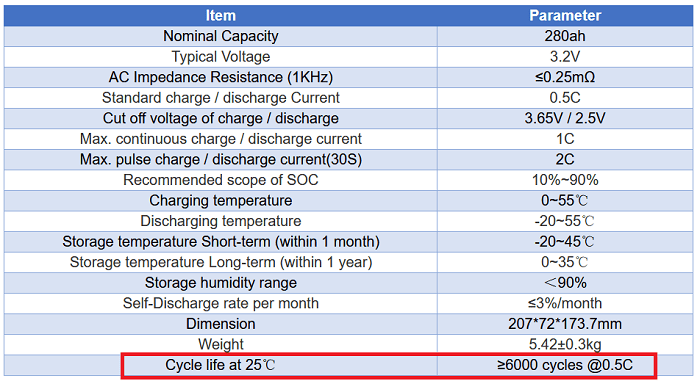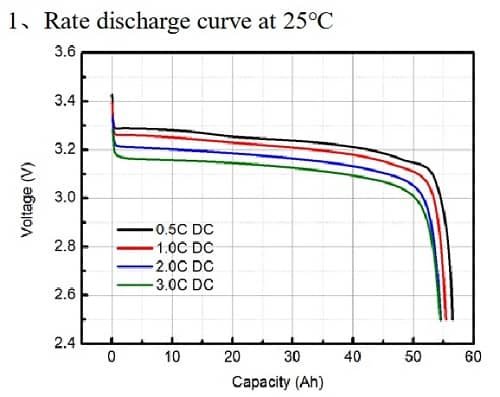LiFePO4 batteries are popular for various applications, including:
- Electric vehicles
- Solar power storage
- Backup power systems
One of the most common questions about these batteries is how long they last.
In this article, we’ll provide a detailed answer to the question, “How many years do LiFePO4 batteries last?”.
The Average Lifespan of LiFePO4 Batteries
LiFePO4 batteries are known for their longevity, safety, and durability. While the exact lifespan of these batteries can vary based on several factors, they typically last between 5,000 and 7,000 cycles. If you charge and discharge the battery once per day, it can last for about 13 to 19 years.

After this time, the battery still holds 80% of its capacity.
Factors that can affect the lifespan of LiFePO4 batteries include the following:
- The quality of the battery: Higher-quality batteries tend to last longer than lower-quality ones.
- How the battery is used: Using the battery in extreme temperatures or discharging it too deeply can shorten its lifespan.
- How the battery is charged: Overcharging or undercharging the battery can also reduce its lifespan.
- How quickly is the battery charged or discharged? If they are cycled at a high C-rate, the lifespan will reduce.
How to Extend the Lifespan of LiFePO4 Batteries
While LiFePO4 batteries have a relatively long lifespan, you can take steps to extend their life even further. Here are some tips for maximizing the lifespan of your LiFePO4 battery:
- Avoid overcharging or undercharging the battery: Make sure to keep the battery between 10 and 90% of its rated capacity.
- Keep the C-rates low.
- Use the battery in a moderate temperature range: LiFePO4 batteries work best in temperatures between 59°F and 95°F or 15°C and 35°C. Avoid using the battery in hot or cold (freezing) temperatures.
In the image below, you can see that the amount of cycles the battery can do depends highly on the temperature of the battery cells. At 25°C or 77°F, the cell can do 6,000 cycles while still having 80% of its capacity left.
On the other hand, at 45°C or 113°F, the cell can only do 2,800 cycles until it has 80% of its capacity left over.

Increase the lifespan of your LifePO4 battery
Cycle life of a lithium battery
Lithium batteries are known for their long cycle life of up to 6,000 cycles. After those 6,000 cycles, there will still be 80% of the capacity left. To put that into perspective, that’s 16 years of daily cycling of the battery.
Now, those 6,000 cycles are reached when you don’t discharge below 10% and charge over 90%. That means a 100Ah battery has a usable capacity of 80Ah to reach 6,000 cycles. If you use the whole capacity of the battery, then you can get 4,000 cycles, which still is a lot.
Temperature of lithium batteries
You need to keep the temperature of the battery cool too. Going over 40°C or 104°F will make your battery age faster, thus decreasing its cycle life.

C-rate with a lithium battery
The same goes for the charging and discharging rate of the battery. As you might already know, the C-rate is used for a battery’s discharge and charging speed. A 100Ah at 1C discharge is getting a load of 100Amps. The battery can handle this, but it’s not ideal.
Try to have a charging and discharging rate of 0.2C for your battery. This is a 20amp charge or discharge current for a 100Ah battery. One way to increase your charging and discharging rate is to increase your battery’s Ah (capacity). Buy a 280Ah cell, and you can charge and discharge at 56Amps for maximum cycle life.

To increase the battery capacity (Ah), put the batteries in parallel. To increase the voltage, wire the batteries in series. Read more about wiring batteries in series or parallel.
Compression for lifepo4 batteries
You might have heard about compressing the cells for increased lifespan if you build your batteries yourself. This is done at 300kgf (kilogram-force) or 3000 newtons. This doesn’t necessarily mean that you need to compress them. Using nylon tape around the cells is a great option. The idea here is to make it almost impossible for the cells to expand to limit gas formation.
LiFePO4 Battery Voltage Charge Curve
Below you can see the charge curve of a LiFePO4 battery cell.

We can see that the voltage of the cell is very flat. That’s why it’s recommended to use a shunt in order to determine the battery state of charge (SOC). From the beginning of 10% to the end at 90% we will see a flat line. Before and after this point the voltage increases fast.
Conclusion
LiFePO4 batteries are an excellent choice for various applications thanks to their durability and long lifespan.
While the exact lifespan of these batteries can vary based on several factors, they typically last between 2,000 and 5,000 cycles. By following the tips in this article, you can extend the lifespan of your LiFePO4 battery even further.

I’m an off-grid enthusiast. I created this website to give clear and straight-to-the-point advice about solar power. I’m also the author of the book ‘Off-grid solar power simplified‘. Read more about me on my about page, check out my Youtube channel, or send me a message.
